Hiking and Birding in Agasthiyamalai Biosphere Reserve
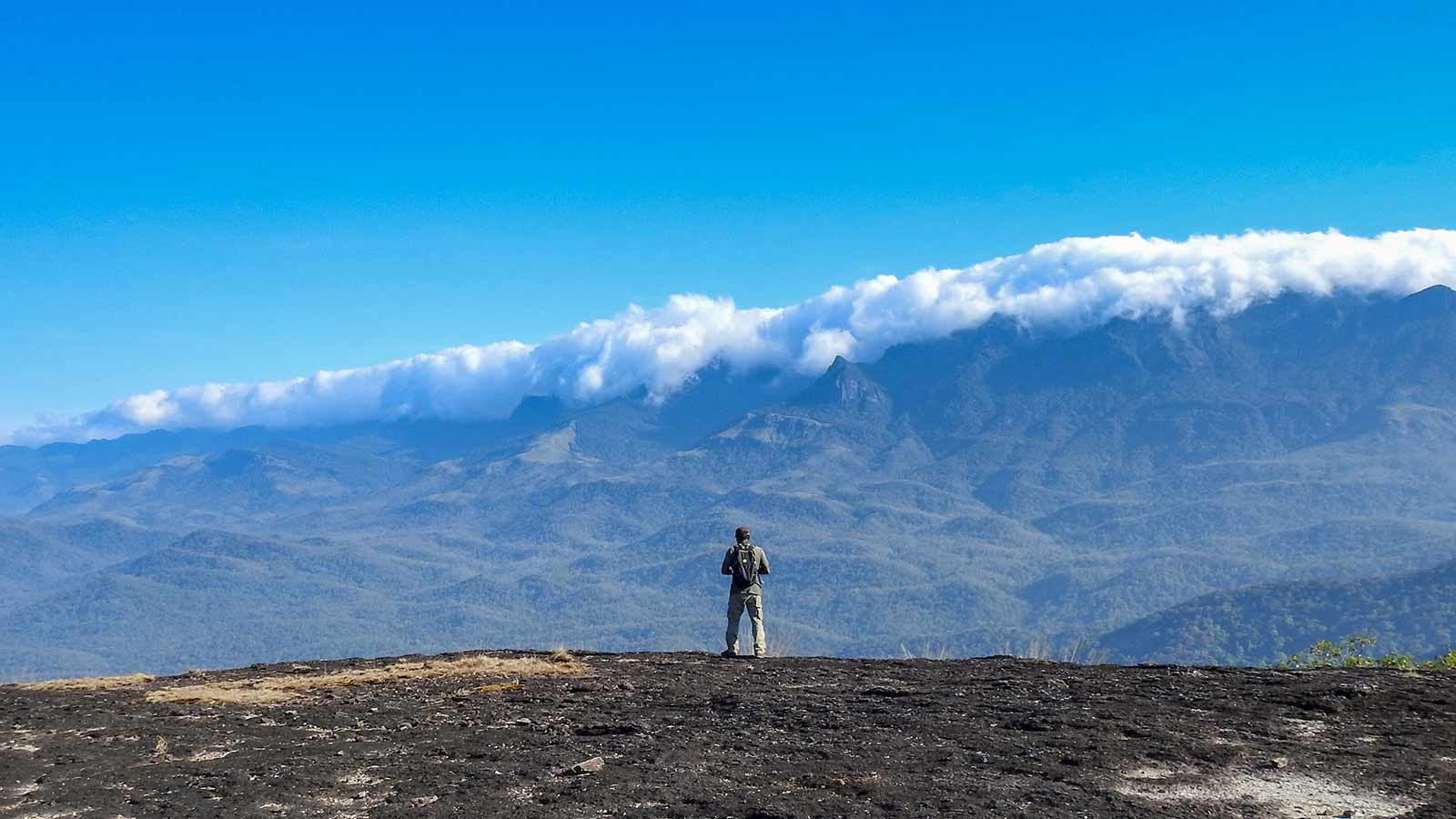
Agasthiyamalai range is one of the last remaining biodiversity hotspots in Western Ghats. Vinod and myself just stood there in this viewpoint intaking the grand view infront of us. The Clouds looked like they were spilling out from those peaks.
Agasthiyamalai Biosphere Reserve is listed under UNESCO’s world list of biosphere reserves. The Reserve spreads across Tamilnadu and Kerala states for 3500 sq.km. It comprises Neyyar, Peppara and Shendurney Wildlife Sanctuaries. Agasthyarkoodam is 6129 ft. tall peak of the Pothigai mountain range. This place is famous among hindu devotees for the sage Agasthiyar as there is a small statue of him on the top of the peak. For nature lovers, this place is truly a biodiversity hotspot hence it’s a paradise. We got an opportunity to visit Neyyar side of Agasthiyamalai reserve. We were very eager to see the birds , butterflies , wildflowers and mammals in this enchanting forest.
We arrived at Neyyar Wildlife Sanctuary very early in the morning and just waited near the boating area.The place was calm and serene except for the constant mooing of a cow tied to a tree nearby. To escape from that repetitive sound we just wandered around. A gorgeous Grey Count butterfly was gliding and sat gently on a leaf.
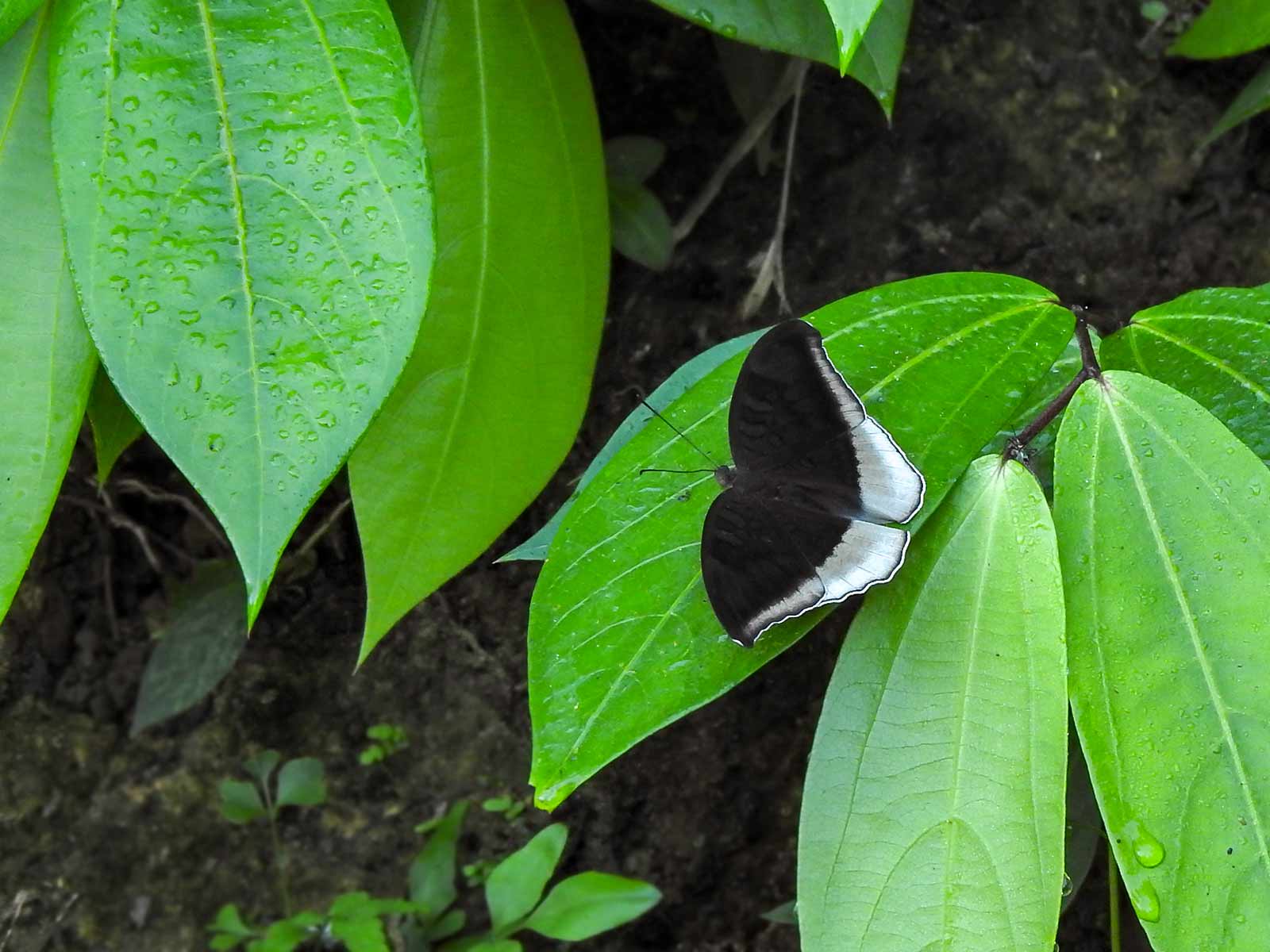
Grey count is a brown butterfly with beautiful broad border which is found in South and Southeast Asia. When this butterfly just basks with open wings it gives you a perfect tropical feeling.
This nymphalid butterfly has beautiful color combination and is one of my favorites. As we were looking at the butterfly a pair of Malabar grey hornbills flew across the neyyar river and landed on a tree near us. They were very restless and hopped on the branches. While we were watching these little activities, we forgot about the cow but suddenly we heard another sound. But that was not a “Moo” but a “Roar”. For the first time in our life , we heard the roaring of a LION. Lions are extinct in wild elsewhere in India except for Gir forest , Gujarat. In Neyyar there is a Lion Safari Park and the roar came from there. I don’t think the lions in this safari park are none different than the one we see in Arignar Anna Zoological Park , Chennai but still the roar was awesome. We came back to the place where the cow was still mooing and then started off with the forest officials to our trekking place.
The base of the trekking place was covered with invasive creepers which was a big disappointment for me. We started walking inside the thick forest and soon we were inside a beautiful old-growth forest.
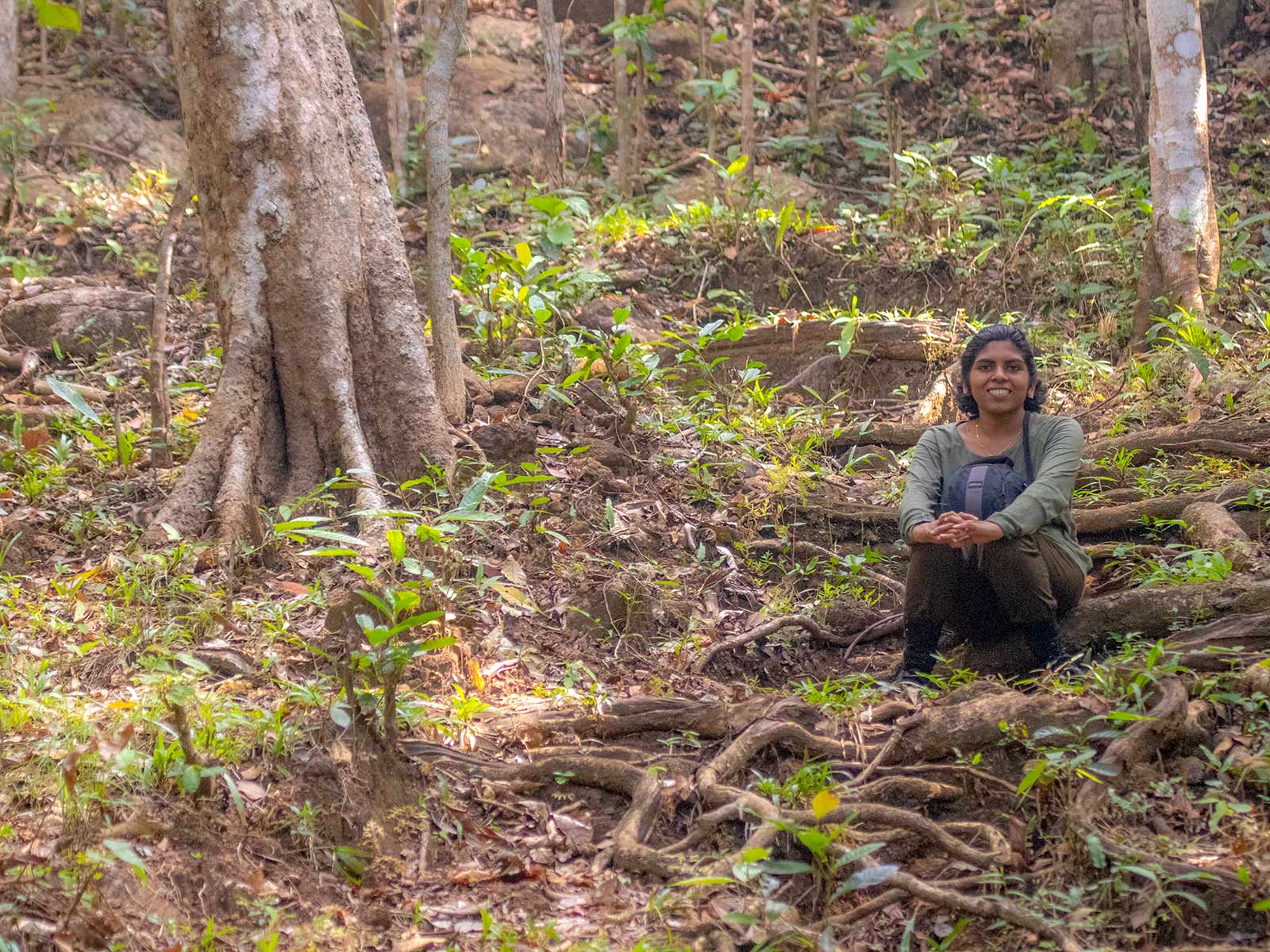
The forest floor was fully intertwined with roots of trees. Sitting on the roots of these old trees made me feel like sitting on a forest throne but I checked for insects or snakes before sitting on the forest floor. If in wet season, I would have been covered with leeches for sitting like this on the forest floor.
There were birds flock on the top of the tall trees where sunlight hits but we couldn’t spot any of them. There were wide variety of trees and many of the lianas had big thorns. So we were very careful about where we were keeping our hands when we had to balance. There were lots of trees from Areaceae family. They looked very beautiful in that dark forest especially the young ones. I was fascinated by many little things on the forest floor like a shell of a beetle , wing of a dead butterfly , broken egg shell of a bird, some mushrooms and the list went on. I picked up everything in my hand and showed it to vinod , then kept it back in the same place where I found.
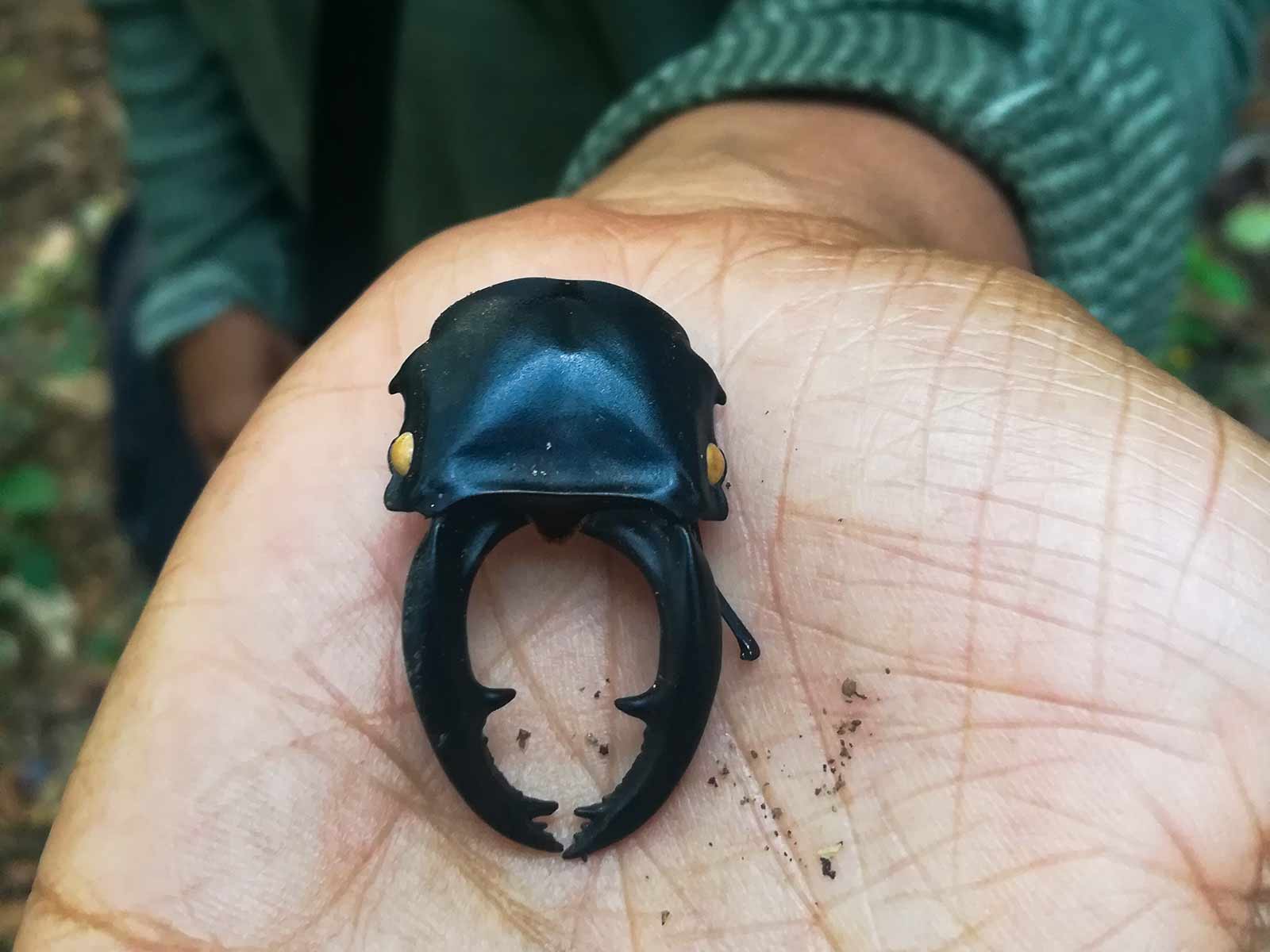
I found this dead Staghorn beetle on the forest floor and the beetle had quite an armor. In some areas they were used as amulets it seems. It looked like a mini rhinoceros to me.
The forest floor was covered with dried up leaves and we were searching for forest ground birds who love pecking up these leaves. We saw Orange-headed ground thrush soon but we kept searching for Indian Pitta or any Jungle fowls. After some quite walking the forest official who came with us showed a bird on the ground. Seeing the size from distance, I thought that should be some jungle fowl. The bird was sitting in a shady area and we approached cautiously. I was surprised when I saw the bird through the binocular to know that it was the elusive Imperial Pigeon. I didn’t expect this bird to sit on a forest floor as we had always seen them on tall trees. The Imperial Pigeon noticed us and flew to the nearby tree with dense foliage. We continued our walk while I was intaking my surroundings in every step. As we were losing virgin forests every day , it was really a privilege for nature lovers like us to walk inside a magestical forest in South India. The sad part is you don’t get to see many wildlife when you walk in a dense jungle.
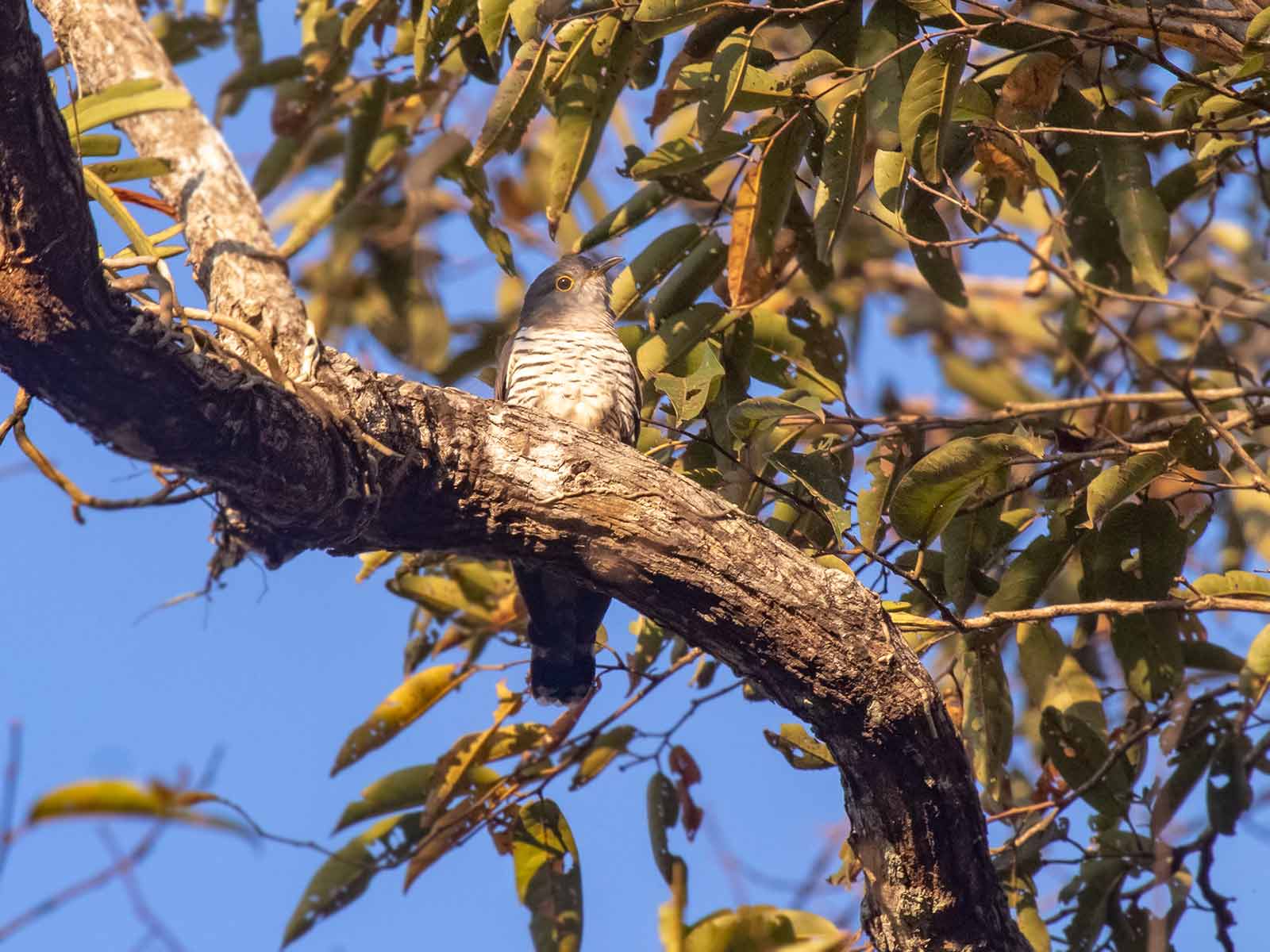
Cuckoos usually feed on the upper canopy. So when Vinod spotted this Indian Cuckoo silently sitting on a tree , we were delighted. Cuckoos are famous for their brood parasite behavior. They lay their eggs mostly on drongos and crows nest.
After some quick and steep climb, the undergrowth and trees started getting different from the ones we saw in the base of the forest. We stopped near a small cave and rested for sometime seeing the beautiful scenery infront of us. Suddenly there was some movement inside the dense shrubs. We all froze and waited to see who made all those commotions. A Sambhar deer came out and jumped to the other side in a blink of an eye. Vinod went to check the cave before continuing our hike. He saw a bat hanging inside the cave and after a great deal of difficulty took a picture without a flash.
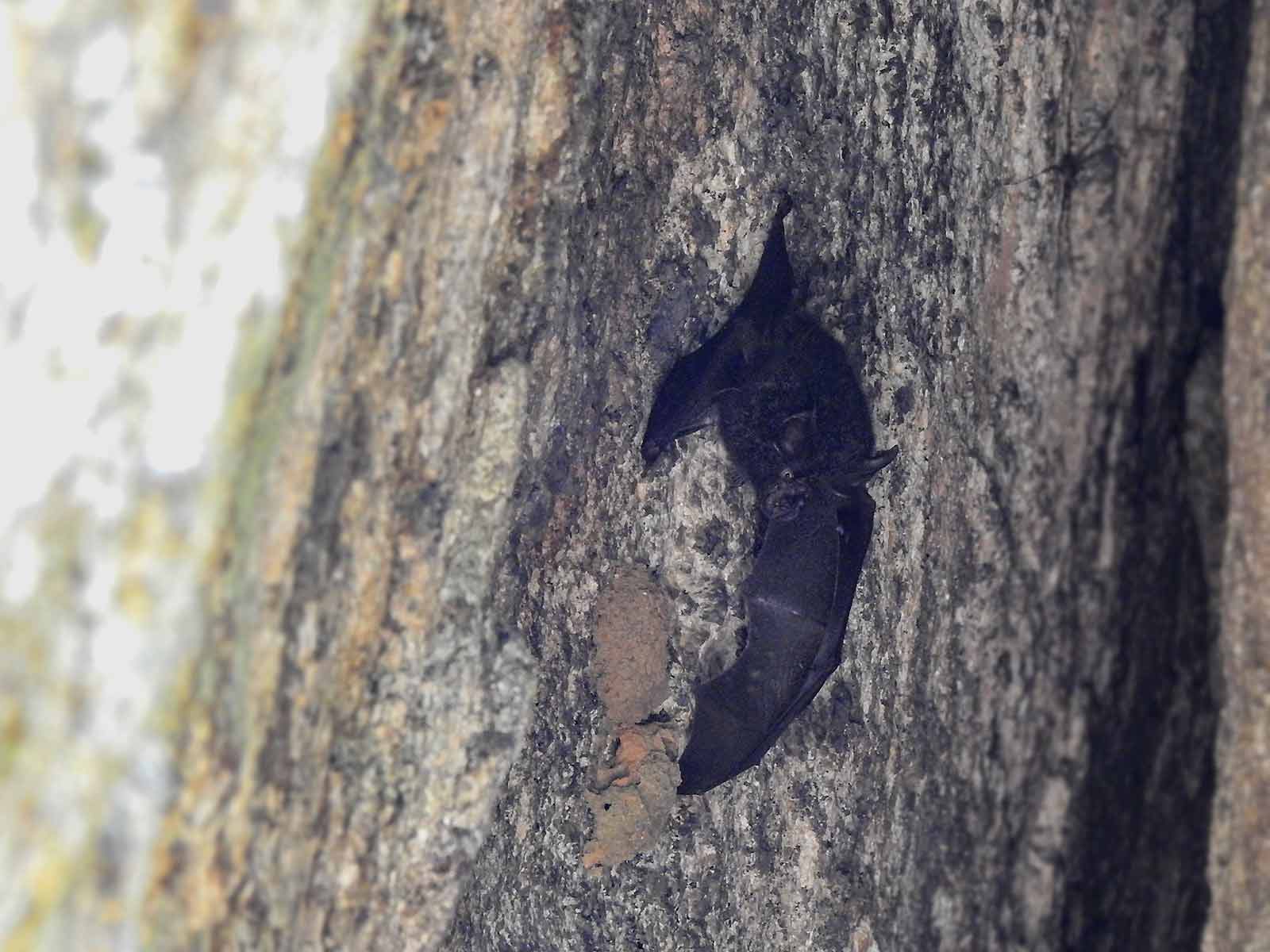
Bats are always considered as a bad omen , a carrier of disease in this world which ironically loves “BATMAN”. Me and Vinod had read many articles about bat species and always fascinated about them. We wish to see the different bat species but so far we can identify only the fruit bat.
We continued our climb and after sometime we reached the grassland. The grasslands are always the best part in climbing up the mountains. The grasses were not yet dried up here but all the flowering plants had dried up. It was already mid-day but the breeze was very pleasant. So we didn’t feel any tiredness and continued our climb. Vinod spotted a parasite plant and a single orchid amidst the tall grasses. We reached the peak after some more climb and we had a breath-taking view. There was a single long billed pipit standing on a rock but no other birds in sight.So we just relaxed and enjoyed the view. We were surrounded by other tall mountains in Agasthyamalai and we enjoyed our time far away from civilization.
Viewpoint in Agasthyamalai
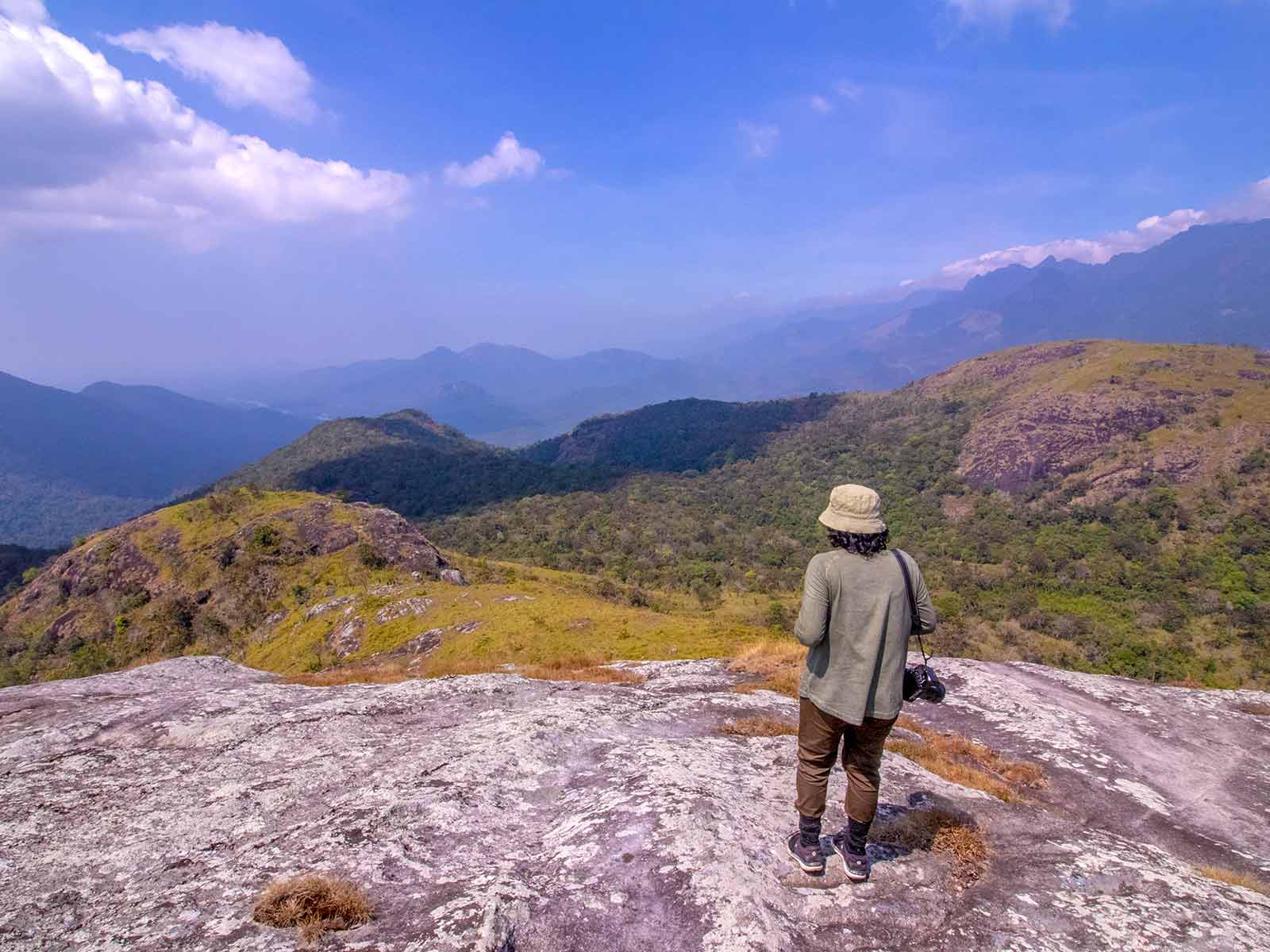
The climb to vengulamedu was steep but not a very tough climb. When you reach any peaks you will always enjoy the bird’s eye view. This agasthiyamalai range made us feel exuberant and we were totally surrounded by Mother nature.
After spending good time in the peak, we started to climb down. If you think the climb down was easier, you are wrong. The climb down in dry leaves was very tough than the climb up. We were slipping up in every step and couldn’t keep our hands on the trees as there were many thorns. We walked in different route on our way back. Suddenly Vinod stopped and told me to move away quickly without looking up. I moved like he said without questioning as I understood there was some danger from his voice. Then he called the forest official and showed the long snake on the tree. It was just the rat snake but seeing it in a dense jungle made me imagine it like an “Anaconda”. I took few more steps from the tree and also had a cautious eye on other trees. Vinod on the contrary was very excited seeing the snake.
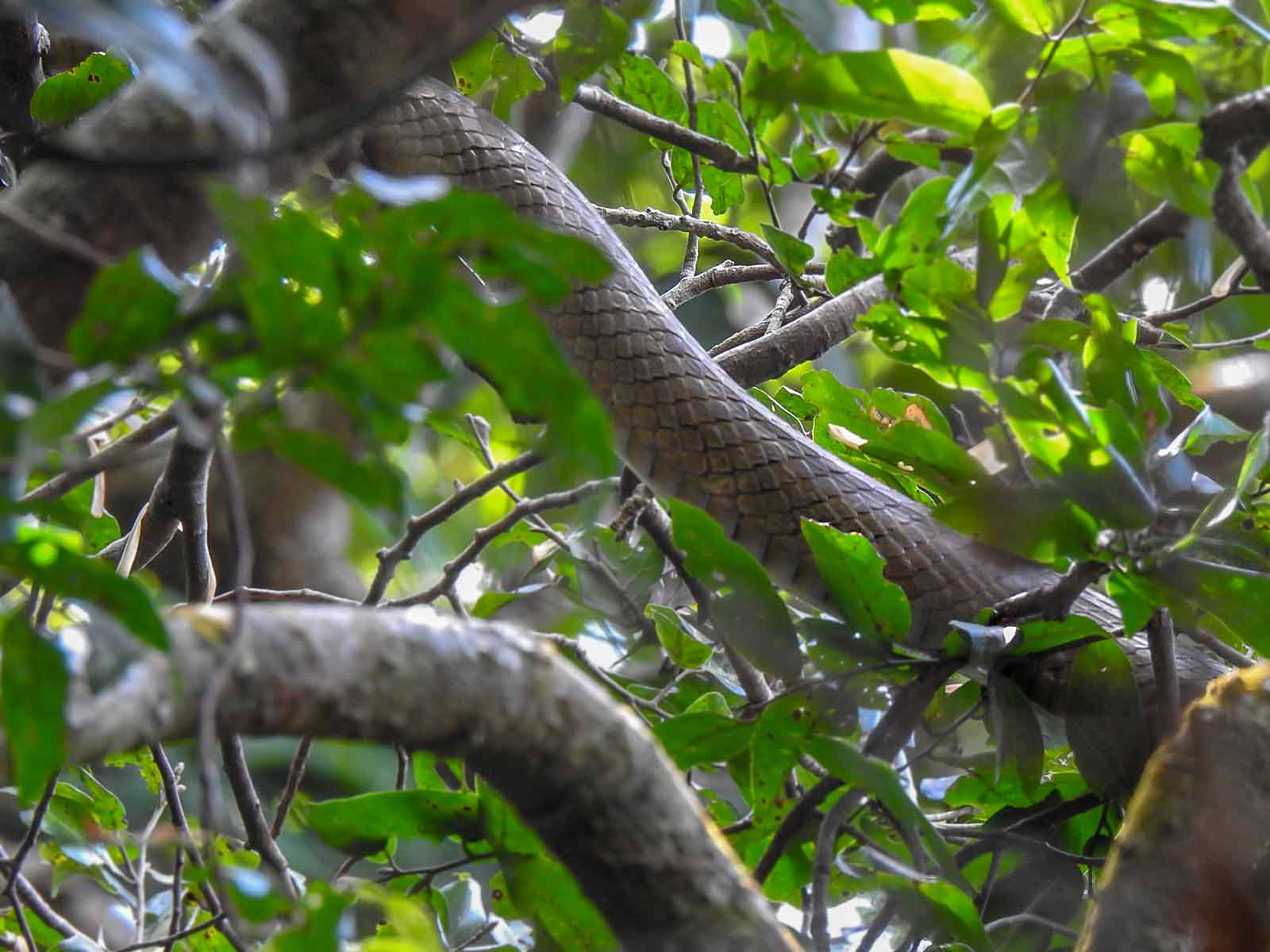
Which is the SNAKE and Which is the BRANCH ? When you don’t look where you keep your hands in a forest, you may easily have a snake in hand !!
Seeing his enthusiasm on sighting the snake, the forest official told if only I had known your interest on snakes earlier I would have shown you all the pit vipers I spotted early in this walk. Vinod was very upset that he didn’t see any pit viper, so he kept on searching till we reached the base. I was silently glad that I didn’t see any pit vipers.
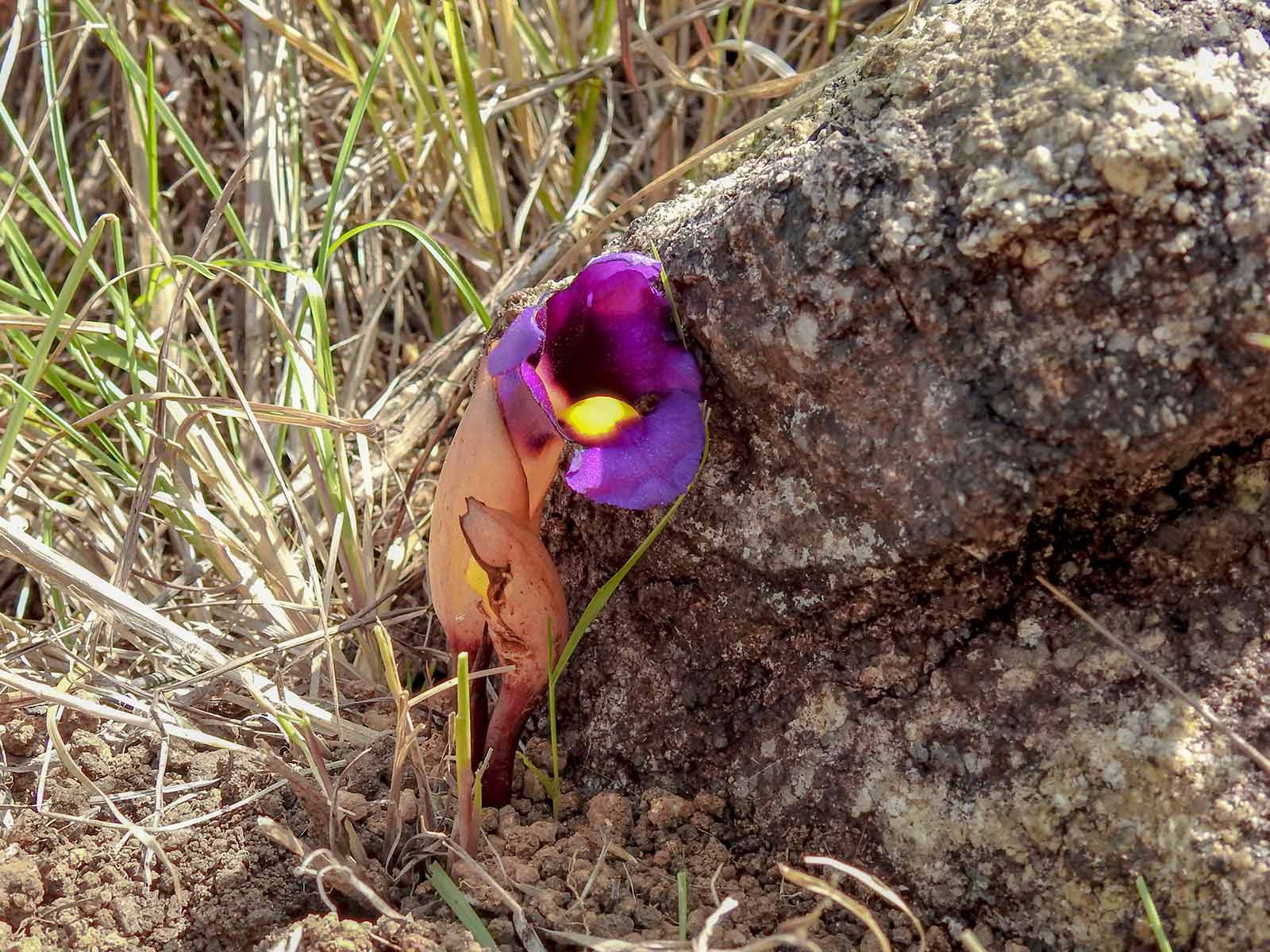
Aeginetia pedunculata is a root parasite with beautiful violet flower. The bright yellow color inside the flower looked like something glowing within it. Only in Disney movies we get to see these fairy , glowing flowers.
When we were about to end our walk there was a loud thud infront of us. We all walked closer to see a dead Malabar Giant Squirrel was thrown by someone from the tree. We searched on the trees to see the raptor who had the strength to lift this heavy squirrel. A Changeable hawk eagle circled back to check his meal. We were saddened that the eagle missed his food , so we quickly moved from the place. Hope the eagle picked up the squirrel again and had a stomach full meal. We reached the starting point and enjoyed a beautiful sunset behind the mountains. I loved the wonderful trek I took after a long time inside the enchanting Western Ghats.